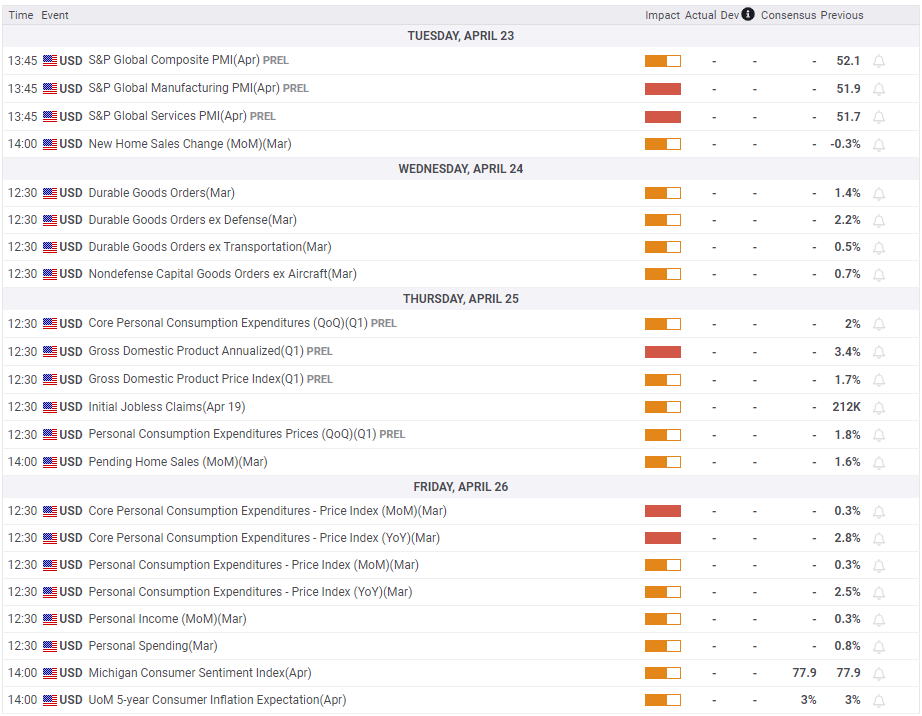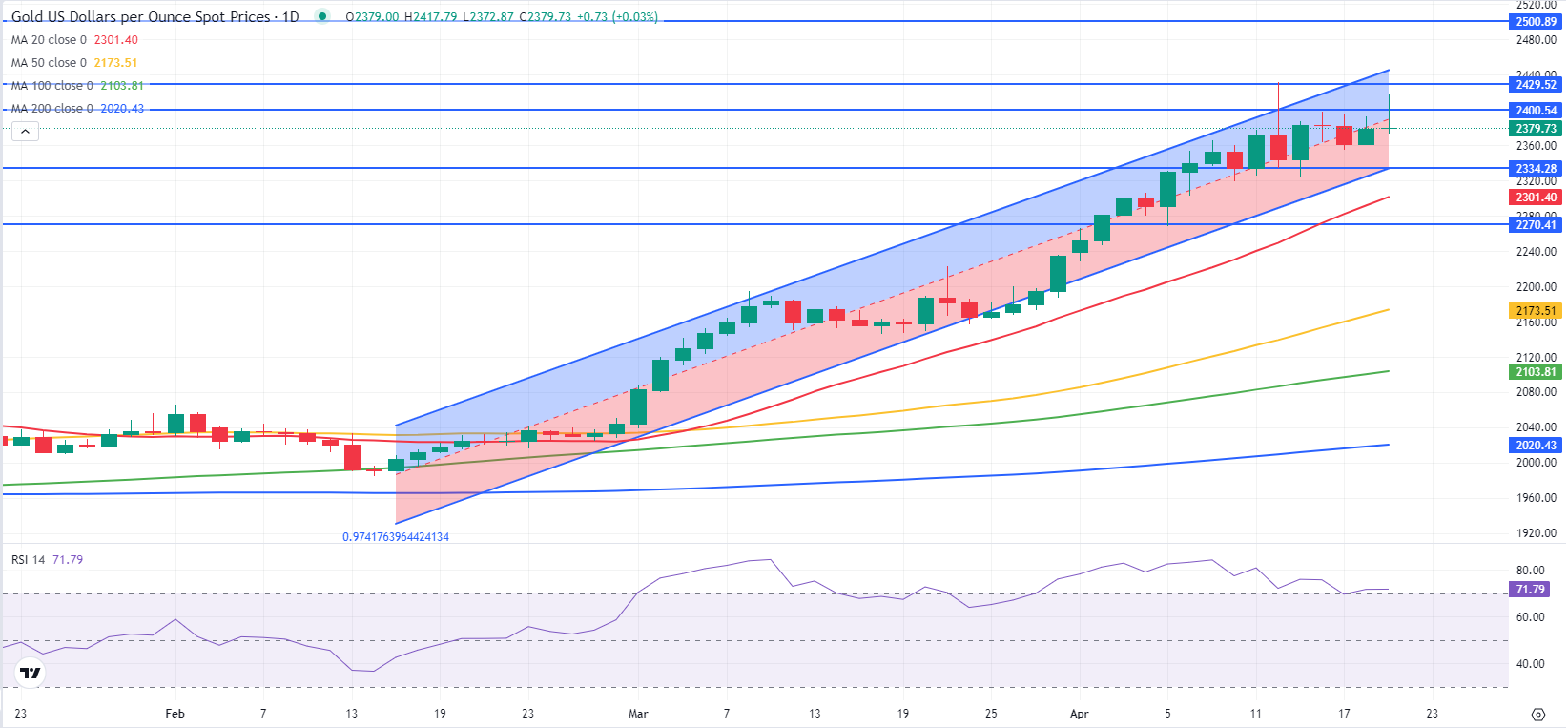- Gold struggled to find direction as markets assessed geopolitical developments this week.
- The near-term technical outlook suggests that the bullish bias remains intact.
- Investors will scrutinize economic growth and inflation data from the US next week.
Gold (XAU/USD) price fluctuated in a relatively narrow range this week following the record-setting rally. Investors will continue to pay close attention to headlines surrounding the Iran-Israel conflict and scrutinize key macroeconomic data releases from the US next week.
Gold retreated after spiking above $2,400
Gold benefited from safe-haven flows and gathered bullish momentum at the beginning of the week as markets reacted to news of Iran launching an assault over the weekend, with dozens of drones and missiles in retaliation to the suspected Israeli attack on Iran’s consulate in Damascus on April 1. Gold gained more than 1.5% on Monday and registered its highest daily close on record. Meanwhile, the data from the US showed that Retail Sales rose 0.7% on a monthly basis in March. This reading came in better than the market expectation for an increase of 0.3% but XAU/USD ignored the renewed US Dollar (USD) strength.
As Western nations called upon Israel to avoid a further escalation of the conflict and reported plans of widening sanctions against Iran, market mood improved slightly on Tuesday and made it difficult for Gold to build on Monday’s gains. Meanwhile, hawkish comments from Federal Reserve (Fed) officials lifted the benchmark 10-year US Treasury bond yield to its highest level since early November, near 4.7%, and didn’t allow XAU/USD to gain traction.
Fed Chairman Jerome Powell said that the recent data indicated a lack of significant progress on inflation this year and added that they can maintain the current rate as long as needed if higher inflation were to persist. Additionally, San Francisco Fed President Mary Daly said that they need to be confident that inflation is on its way to the 2% target before taking a policy action. “The worst thing to do is act urgently when urgency isn't necessary,” Daly argued.
In the absence of high-tier data releases, Gold staged a downward correction and closed in negative territory on Wednesday. As markets turned subdued on Thursday, XAU/USD struggled to find direction and ended the day little changed.
In the early trading hours of the Asian session on Friday, reports of Israeli missiles striking Iran triggered a flight to safety. With the knee-jerk reaction, Gold spike above $2,400. Although Israel did not immediately confirm a retaliatory attack against Iran, several news outlets said Israel carried out the strikes, citing US officials.
Following this development, however, the market mood improved on easing concerns over a further escalation of the conflict. A senior Iranian official told Reuters that there was no plan for an immediate retaliation because there was no clarification on who was behind the incident, while CNN reported that a regional intelligence source told the outlet that direct state-to-state strikes between Israel and Iran were over. In turn, Gold retreated below $2,400 and retraced its daily advance.
Gold investors await key US data
Market participants will stay focused on geopolitics next week. A de-escalation of the Iran-Israel crisis could trigger a downward correction in XAU/USD and cause the market focus to shift to the US data. On the other hand, another retaliatory response by Iran could revive fears over a deepening crisis in the Middle East and allow Gold to continue to capitalize on safe-haven demand.
On Thursday, the US Bureau of Economic Analysis (BEA) will release the Advanced Gross Domestic Product (GDP) data for the first quarter. In case the US economy posts a stronger-than-forecast annualized growth, the USD could hold its ground and weigh on XAU/USD. Since the beginning of April, Gold has been ignoring rising US yields and the broad USD strength. If geopolitics finally move to the back burner, Gold could come under bearish pressure, with investors adjusting their positions to growing expectations for a Fed policy hold in June. According to the CME FedWatch Tool, there is a less than 20% chance the Fed will lower the policy rate by 25 basis points in June.
On Friday, the BEA will publish the Personal Consumption Expenditures (PCE) Price Index data, the Fed’s preferred gauge of inflation, for March. Thursday’s GDP report will include the PCE Price Index data for the first quarter. Hence, Friday’s PCE reading will not offer any surprises and is unlikely to trigger a market reaction. Moreover, Fed Chairman Powell said that the annual core PCE inflation was little changed in March, according to their estimates.
Gold technical outlook
The Relative Strength Index (RSI) indicator on the daily chart retreated this week but it has yet to drop below 70 to signal the beginning of an extended downward correction. On the downside, the lower limit of the ascending channel from mid-February aligns as first support at $2,335. In case XAU/USD drops below this level and starts using it as resistance, additional losses toward $2,300 (20-day Simple Moving Average) and $2,270 (static level) could be seen.
Resistances are located at $2,400 (psychological level, static level), $2,430 (static level) and $2,500 (psychological level).
Gold FAQs
Gold has played a key role in human’s history as it has been widely used as a store of value and medium of exchange. Currently, apart from its shine and usage for jewelry, the precious metal is widely seen as a safe-haven asset, meaning that it is considered a good investment during turbulent times. Gold is also widely seen as a hedge against inflation and against depreciating currencies as it doesn’t rely on any specific issuer or government.
Central banks are the biggest Gold holders. In their aim to support their currencies in turbulent times, central banks tend to diversify their reserves and buy Gold to improve the perceived strength of the economy and the currency. High Gold reserves can be a source of trust for a country’s solvency. Central banks added 1,136 tonnes of Gold worth around $70 billion to their reserves in 2022, according to data from the World Gold Council. This is the highest yearly purchase since records began. Central banks from emerging economies such as China, India and Turkey are quickly increasing their Gold reserves.
Gold has an inverse correlation with the US Dollar and US Treasuries, which are both major reserve and safe-haven assets. When the Dollar depreciates, Gold tends to rise, enabling investors and central banks to diversify their assets in turbulent times. Gold is also inversely correlated with risk assets. A rally in the stock market tends to weaken Gold price, while sell-offs in riskier markets tend to favor the precious metal.
The price can move due to a wide range of factors. Geopolitical instability or fears of a deep recession can quickly make Gold price escalate due to its safe-haven status. As a yield-less asset, Gold tends to rise with lower interest rates, while higher cost of money usually weighs down on the yellow metal. Still, most moves depend on how the US Dollar (USD) behaves as the asset is priced in dollars (XAU/USD). A strong Dollar tends to keep the price of Gold controlled, whereas a weaker Dollar is likely to push Gold prices up.
Information on these pages contains forward-looking statements that involve risks and uncertainties. Markets and instruments profiled on this page are for informational purposes only and should not in any way come across as a recommendation to buy or sell in these assets. You should do your own thorough research before making any investment decisions. FXStreet does not in any way guarantee that this information is free from mistakes, errors, or material misstatements. It also does not guarantee that this information is of a timely nature. Investing in Open Markets involves a great deal of risk, including the loss of all or a portion of your investment, as well as emotional distress. All risks, losses and costs associated with investing, including total loss of principal, are your responsibility. The views and opinions expressed in this article are those of the authors and do not necessarily reflect the official policy or position of FXStreet nor its advertisers. The author will not be held responsible for information that is found at the end of links posted on this page.
If not otherwise explicitly mentioned in the body of the article, at the time of writing, the author has no position in any stock mentioned in this article and no business relationship with any company mentioned. The author has not received compensation for writing this article, other than from FXStreet.
FXStreet and the author do not provide personalized recommendations. The author makes no representations as to the accuracy, completeness, or suitability of this information. FXStreet and the author will not be liable for any errors, omissions or any losses, injuries or damages arising from this information and its display or use. Errors and omissions excepted.
The author and FXStreet are not registered investment advisors and nothing in this article is intended to be investment advice.
Recommended Content
Editors’ Picks

EUR/USD Gains look limited by 1.1570 Premium
EUR/USD trades well on the defensive for the second day in a row, revisinting the mid-1.1300s on the back of the continuation of the upside impulse in the US dollar. The move followed firmer US PMI data and news indicating the White House may be considering tariff cuts on Chinese imports.

GBP/USD deflates to the sub-1.3300 area, USD bulls prevail
GBP/USD remained on the back foot Wednesday, slipping below the 1.3300 level as the Greenback gained further traction. The Dollar’s solid performance was supported by strong US data and fading concerns over a renewed escalation in the US–China trade dispute.

Gold corrected extreme conditions, struggles around $3,300
Gold extended its decline on Wednesday, slipping below the $3,300 mark per troy ounce in response to reports from the media suggesting the Trump administration is weighing tariff reductions on Chinese goods, a news that revived hopes of easing trade tensions and reduced demand for the yellow metal as a safe-haven asset.

Bitcoin bullish momentum builds as premium exceeds 9% for first time in three months
Bitcoin price is extending its gains, trading above $94,000 at the time of writing on Wednesday, following a two-day rally of 9.75% so far this week. BTC rally gathers momentum as trade war fears ease, following US President Donald Trump’s downplaying of tensions with China.

Five fundamentals for the week: Traders confront the trade war, important surveys, key Fed speech Premium
Will the US strike a trade deal with Japan? That would be positive progress. However, recent developments are not that positive, and there's only one certainty: headlines will dominate markets. Fresh US economic data is also of interest.

The Best brokers to trade EUR/USD
SPONSORED Discover the top brokers for trading EUR/USD in 2025. Our list features brokers with competitive spreads, fast execution, and powerful platforms. Whether you're a beginner or an expert, find the right partner to navigate the dynamic Forex market.

